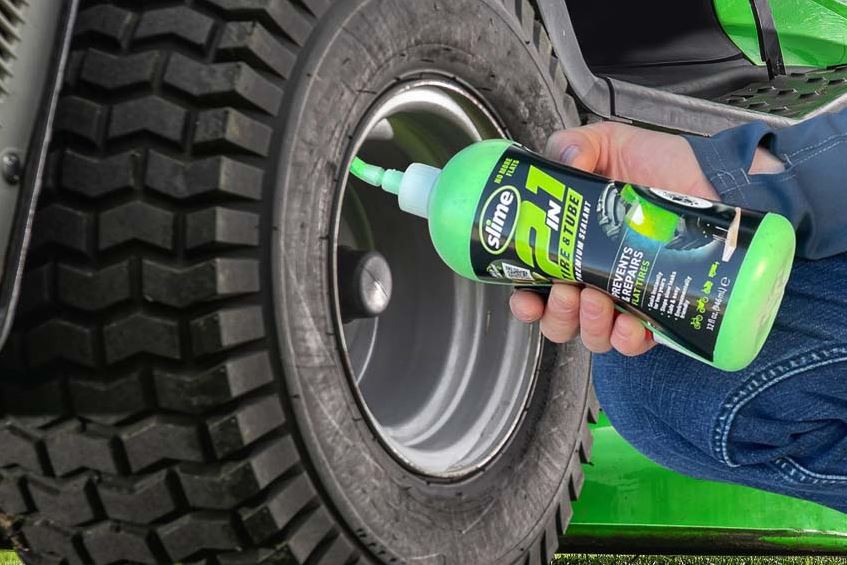Slime tire sealants fill the spaces between the tubeless tires and inner tubes to avoid punctures on the tires and prevent air from escaping.
The environmentally friendly substance, like every other tire care product, has a limited period for usage. If you are about to use the sealant, you may wonder how long the liquid will take to dry out.
There are two ways to look at it: the life of slime tire sealants after they’ve been used on tires and the life of slime tire sealants after they’ve been stored and left in their original packaging.
This article will answer all your questions about using slime tire sealants.
Table of Contents
How Long Does Slime Tire Sealant Last?
According to the manufacturer, Slime tire sealants will suffer wear and tear in most tires and tubes after 2 years. In other words, you will enjoy the maximum puncture protection and optimal performance of Slime sealants for two years, after which they need to be replaced.
On the other hand, if you store the green liquid in its original packaging in a cool, dry place without using it, it will last for four years (from the date of manufacturing)
So if you have a Slime sitting in your garage for a while and suddenly want to use it, check the age of the sealant in a squeeze bottle by locating the production date code above the label. It will only be effective if it’s within four years.
How Do Slime Tire Sealants Work?
Sealants need no introduction to the car repair landscape. Slime is one of the manufacturers of these anti-puncture liquids.
When you apply slime tire sealants to the tread area punctures on your tire, the liquid coats the inside of the tire (or tube) within the tread area and seals it.
The escaping air takes the sealant to the puncture, then the liquid portion of the sealant escapes. The fibers and binders build up and intertwine to form a flexible plug, allowing the product to seal the puncture in the tread area almost instantly.
Is it Safe To Use Tire Sealants?
While it is generally safe to use tire sealants, some products are safer than others. If your vehicle has TPMS sensors, you want to be extra careful about the type of tire sealant you use. Sealants made with latex or ethylene can jeopardize the TPMS sensor, the wheels, and the tire due to the oversaturation of ammonia.
So it is best to use non-toxic sealants, and a slime is an ideal option. The company, on its website, reiterated that the sealants are environment-friendly, non-toxic, and safe for use in tires. Thus not posing any harm to your tires, rims, or TPMS system.
If you have been using slime sealant, I recommend you stick with it. But other sealant companies are safe and environmentally friendly that you can consider. Make sure you go through their product reviews before shelling out cash.
Does Slime Sealant Harden After It Is Installed?
After installing slime sealant, it doesn’t harden. Rather, the sealant remains liquid for up to two years.
As a delivery system for fibers, rubber particles, and other sealing agents, slime carries larger puncture-repairing ingredients to pack and seal the hole to avoid air loss. This happens as the liquid gets forced out through the puncture.
Can I Use Slime Sealants On Bicycle Tires?
Yes, you can apply slime tire sealants to bicycle tires. Many people believe slime tire sealants are useful for all types of tires. But looking at the specifications provided by the manufacturer, the green substance will only be effective for specific tires.
These include bicycle tires, motorcycle tires, truck tires, compact car tires, and non-highway vehicle tires.
Pros & Cons of Using Sealants On Tires
There are several benefits to using sealants on tubeless tires. Despite these perks, the green liquid also has some drawbacks. Here are the pros and cons of using slime sealants:
| Pros | Cons |
| seal small punctures or leakage within minutes, allowing you to continue your trip. | Sealants can only seal small-size punctures, especially those between 4 and 6 mm. However, products like Ride-on and OrangeSeal are breaking the odds. |
| Versatile for tube and tubeless tires | Not recommended for repairing cuts, slices, or sidewall damage in tires. |
| Being liquid in nature, the sealant seals a puncture almost immediately when your tire gets hit by a sharp object. | Unlike Slime, some sealant products contain chemically active substances that can potentially corrode the rims and harm the TPMS |
| It is ideal for emergencies because there is no need to manually remove the tires or use the plug method to repair punctures. | It can freeze up and cause driving problems, especially during the winter. |
| Thanks to its longevity, there is no need to refill it every time. | |
| Reducing the risk of getting stuck in isolated places | |
| Saves money, time, and effort. |
Wrapping up
The ultimate goal of using a tire sealant is to keep the inner lining in place in the event of a puncture, as all the liquid does is coat the inner lining of the tire and act as a preventative measure against further leaks.
We can draw the curtains on this discussion by saying slime sealants are a great product as they give you two years of relief. CHECK OUT SLIME SEALANT ON AMAZON
But it is not ideal to wait for 2 years before fixing whatever puncture the liquid holds out for. Slime sealants will also be usable for the next four years after being opened.
Remember that these green liquids only act as a fiber transportation mechanism since the air is being rushed out. As the sealant rushes out with leaking air, it leaves the fibers and a plugged tire behind.

